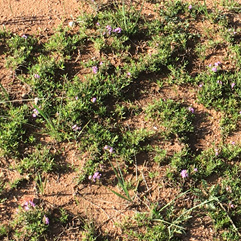

Chinese Journal of Plant Ecology >
Distribution, community characteristics and classification of Thymus mongolicus steppe in China
Received date: 2018-02-26
Revised date: 2018-05-29
Online published: 2018-06-01
Supported by
Supported by the National Basic Research Program of China((2014CB-138800));the Key Program of National Fundamental Scientific Research((2015FY210200))
Thymus mongolicus steppe was a vegetation formation dominated by typical dwarf semi-shrub of Lamiaceae. Based on the previous literatures and primary plot data sampled during the growing seasons from 2015 to 2017, the distribution, ecological features, community characteristics and classification of Thymus mongolicus steppe were summarized. (1) Thymus mongolicus steppe is mainly distributed on the loess hills of Xar Moron River Watershed, Bashang region in the northwest of Hebei Province, the hills surrounding the Yinshan Mountains, the east part of Erdos Plateau and the northern Loess Plateau. This formation occurrs mainly on the stony slopes or loess hills with severe soil erosion. (2) In total, 167 seed plant species belonging to 101 genera of 34 families were recorded in the 91 sample sites, and families of Compositae, Leguminosae and Gramineae played crucial roles in the species composition. Eight of these families were semi-shrub and dwarf semi-shrub species, and 112 were perennial forb species. Typical xerophytes (58 species) and Meso-xerophytes (45 species) account for more than half part of all species. Eight geographic elements were involved. East Palaearctic (70 species) and East Asia (46 species) were the two major floristic elements. (3) Based on life form and dominance of species in the community, the formation was classified into 6 association groups (Thymus mongolicus, dwarf shrubs/dwarf semi-shurbs association group; Thymus mongolicus association group; Thymus mongolicus, bunchgrasses association group; Thymus mongolicus, rhizomatous grasses association group; Thymus mongolicus, Carex association group; Thymus mongolicus, forbs association group), consisting of 28 associations.

GAO Chen-Guang, QIAO Xian-Guo, WANG Zi, LU Shuai-Zhi, HOU Dong-Jie, LIU Chang-Cheng, ZHAO Li-Qing, GUO Ke . Distribution, community characteristics and classification of Thymus mongolicus steppe in China[J]. Chinese Journal of Plant Ecology, 2018 , 42(9) : 971 -976 . DOI: 10.17521/cjpe.2018.0047
| [1] | Chen LZ, Sun H, Guo K ( 2014). Floristic and Vegetation Geography of China. Science Press, Beijing. |
| [1] | [ 陈灵芝, 孙航, 郭柯 ( 2014) 中国植物区系与植被地理. 科学出版社, 北京.] |
| [2] | Editorial Board of the Vegetation Atlas of China, Chinese Academy of Sciences ( 2009). 1: 1000000 Vegetation Atlas of China. Geology Publishing House, Beijing. |
| [2] | [ 中国科学院中国植被图编辑委员会 ( 2007). 中华人民共和植被图(1:1000000). 地质出版社, 北京.] |
| [3] | Nei Mongol and Ningxia Scientific Expedition Group, Chinese Academic of Sciences ( 1985). Vegetation of Nei Mongol. Science Press, Beijing. |
| [3] | [ 中国科学院内蒙古宁夏综合考察队 ( 1985). 内蒙古植被. 科学出版社, 北京.] |
| [4] | Qiao XG, Guo K, Zhao LQ, Liu CC, Zhao HW, Hou DJ, Gao CG ( 2017). Distribution, community characteristics and classification of Stipa tianschanica var. klemenzii steppe in China. Chinese Journal of Plant Ecology, 41, 231-237. |
| [4] | [ 乔鲜果, 郭柯, 赵利清, 刘长成, 赵海卫, 侯东杰, 高趁光 ( 2017). 中国石生针茅草原的分布、群落特征和分类. 植物生态学报, 41, 231-237.] |
| [5] | Wu ZY ( 1980). Vegetation of China. Science Press, Beijing. |
| [5] | [ 吴征镒 ( 1980). 中国植被. 科学出版社, 北京.] |
| [6] | Zhao YZ ( 2012). Classification and Its Florristic Ecological Geographic Distributions of Vascular Plants in Nei Mongol. Inner Mongolia University Press, Hohhot. |
| [6] | [ 赵一之 ( 2012). 内蒙古维管植物分类及其区系生态地理分布. 内蒙古大学出版社, 呼和浩特.] |
/
| 〈 |
|
〉 |